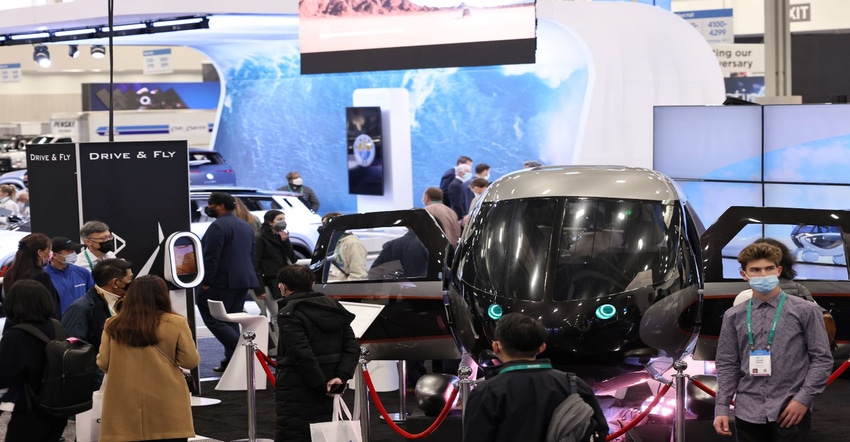From Metaverse to Processors, Technology on Full View at 2023 CES
A look the dazzling array of technologies on display at this year’s Consumer Electronics Show.

The Consumer Electronics Show has long been a showcase for the latest consumer gadgets, which over the years have spanned the gamut from PCs and audio/visual equipment to smartphones and mobile devices, and more recently robotics, wearable devices and electric and autonomous vehicles.
CES 2023 is no exception. Developments in metaverse technology, automotive systems and software, high-speed processors and microcontrollers, video products, wearables and health, are just some of the areas covered at this year’s show, now on display at the Las Vegas Convention Center in Las Vegas January 5th through 8th
Here are some examples of products and technologies on display at this year’s show.
The Metaverse Remains Hot
For instance, Nvidia is announcing several enhancements to its Omniverse Metaverse development ecosystem. New Adobe Substance 3D Painter, Autodesk Alias, PTC Creo, Kitware’s Paraview Omniverse Connectors are now supported on Omniverse Enterprise. Users can also easily export data created in NX Software from Siemens Digital Industries.
The Omniverse DeepSearch AI-powered service lets teams intuitively search through extremely large, untagged 3D databases with natural language or using 2D reference images. Nvidia has also modified its Omniverse Farm user interface provides for improved usability and performance.
Nvidia has also strengthened the core components for its Omniverse Enterprise metaverse development system for businesses. The company has updated Omniverse Kit SDK, the powerful toolkit for building extensions, apps, microservices or plug-ins, making it easier to build advanced tools and Omniverse applications with new templates and developer workflows.

Processor Wars Continue at CES
CES has traditionally been a stronghold for consumer products using the latest high-speed processors, so it is no surprise that there are several major processor announcements at this year’s show.
Intel is introducing 13th Gen Intel® Core™ mobile processors that bring superior performance and experiences for gaming and other high-throughput applications.
The 13th Gen Intel Core H-series mobile processors include the first 24-core processor for a laptop.
The new processor family offers up to 5.6 gigahertz (GHz) turbo frequency, which Intel claims is the highest clock speed available for the laptop market, delivering up to 11% faster single-thread performance and 49% faster multitask performance over the previous generation.
The processor has up to 24 cores (8 Performance-cores, 16 Efficient-cores), 32 threads and enhanced Intel® Thread Director. It provides full memory support of up to 128 gigabyte (GB) total for DDR5 (up to 5,600 megahertz) and DDR4 (up to 3,200 MHz).
Intel’s 13th Gen Intel® Core™ mobile processor supports Intel® Bluetooth LE Audio and Bluetooth 5.2 supporting up to 2x faster speeds and multiple device connections with lower power consumption. It also supports Thunderbolt™ 4 support, delivering transfer speeds up to 40 gigabits per second (Gbps) and PC connectivity to multiple 4K monitors and accessories.

Automotive Developments
Infineon’s TRAVEO II Body MCU family addresses various automotive applications, including body control modules, door, window, sunroof and seat control units as well as in-cabin smartphone terminals and wireless charging units. Infineon’s TRAVEO II Cluster for instrument cluster enables a more robust and feature-rich graphics engine for automotive display systems, including extensive scalability, covering the conventional gauge instrument cluster, hybrid instrument cluster and virtual instrument cluster.
Green Hills’ µ-velOSity RTOS is a tiny, fast and easy-to-program, memory-efficient real-time operating system for a wide range of applications, including those with ASIL requirements. µ-velOSity needs only a few kilobytes of ROM and boots quickly in a minimum of processor cycles. The ultra-small context switch time and fast kernel service calls of this operating system (OS) also make it ideal for real-time automotive functions. And, the clear, concise application programming interface (API) reduces development time and improves product maintainability, cutting costs and speeding up time-to-market. In addition, for developers moving from standalone or no-OS configurations, µ-velOSity provides a well-established migration path.
GEO Semiconductor Inc., which supplies video processors for automotive cameras, and OMNIVISION, a leading global developer of semiconductor solutions including advanced digital imaging, analog and touch & display technology, are demonstrating a solution to simultaneously capture and processing high-quality color (RGB) and infrared (IR) automotive interior video from a single sensor.
This solution combines OMNIVISION’s OX05B1S 5MP RGB-IR image sensor, with GEO’s upcoming GW6 Intelligent Camera Video Processor, which provides industry-leading image processing for the RGB-IR sensor. The GW6 can support the full 5-MP RGB-IR 4x4 pattern of the OX05B1S running at 60FPS and provide two unique video streams with high-quality video for both computer vision and viewing applications. This produces an integrated in-cabin solution for the driver monitoring (DMS) and occupant monitoring (OMS) algorithms while utilizing only one high-resolution RGB-IR image sensor.
The OX05B1S image sensor is built on OMNIVISION’s 2.2-micron PureCel®Plus‑S and Nyxel® pixel technologies. Nyxel delivers the industry’s highest NIR quantum efficiency at 36% (a 3x boost from 12% in the previous generation). The GW6 camera video processor is developed on the TSMC 16nm automotive process and will be offered in a 7 x 7mm fcCSP package (video processing only) or a 17 x 17mm fcCSP package (neural network version).

ON Unveils SiC Chips
With automotive and other applications driving up demand for Silicon Carbide (SiC) transistors, On Semiconductor is expanding its SiC offerings. At CES, ON is showcasing three new members of its EliteSiC family – the 1700 V EliteSiC MOSFET and two 1700 V avalanche-rated EliteSiC Schottky diodes.
With the 1700 V EliteSiC MOSFET (NTH4L028N170M1), On Semiconductor delivers higher breakdown voltage (BV) SiC solutions, required for high-power industrial applications. The two 1700 V avalanche-rated EliteSiC Schottky diodes (NDSH25170A, NDSH10170A) allow designers to achieve stable high-voltage operation at elevated temperatures while offering high efficiency enabled by SiC.
Renewable energy applications are consistently moving to higher voltages with solar systems from 1100 V to 1500 V DC Buses. To support this change, customers require MOSFETs with a higher BV. The 1700 V EliteSiC MOSFET offers a maximum Vgs range of -15 V/25 V, making it suitable for fast switching applications where gate voltages are increasing to -10V, delivering increased system reliability.
At a breakdown voltage rating of 1700 V, the EliteSiC Schottky diode devices offer improved margin between the maximum reverse voltage (VRRM) and the peak repetitive reverse voltage of the diode. The devices also provide good reverse leakage performance with a maximum reverse current (IR) of just 40 µA at 25°C and 100 µA at 175°C.

SiLC Technologies Machine Vision Solution
Machine vision supplier SiLC is demonstrating the EyeonicTM Vision System, which the company claims features the highest resolution, highest precision and longest range while remaining the only FMCW LiDAR solution to offer polarization information.
According to the company, the Eyeonic Vision System integrates the company’s unique photonics technology into the industry’s first available turnkey vision solution, reducing time to market for manufacturers seeking to incorporate machine vision into their products. The system targets robotics, autonomous vehicles, smart cameras and other advanced products.
At the heart of the Eyeonic Vision System is the company’s fully integrated silicon photonics chip. With roughly 10 milli-degrees of angular resolution coupled with mm-level precision, it provides more than 10x the definition and precision of legacy LiDAR offerings. This enables the Eyeonic Vision Sensor to measure the shape and distance of objects with high precision at great distances.
The vision system couples the Eyeonic Vision Sensor and a digital processing solution based on a powerful FPGA. The compact, flexible architecture of the new system enables synchronization of multiple vision sensors for unlimited points/second. The Eyeonic Vision System supports multiple scanner options and gives customers with the flexibility to tailor their designs to maximize performance for distance and field of vision for their application.

MICLEDI Announces Red AlInGaP microLEDs
MICLEDI Microdisplays, which designs microLED (µLED) displays for high-end Augmented Reality (AR) glasses, has produced its first demonstration units of Red µLEDs on AlInGaP starting material. The newest addition to its portfolio of R, G and B µLEDs follows the company’s strategy of optimized display module performance and is manufactured in a CMOS compatible flow, free of arsenide. Demonstration units of both Red GaN and Red AlInGaP will be shown at the company’s booth (#54946) in the Venetian Expo at CES 2023.
MICLEDI’s strategy is to enable true consumer AR glasses by making the best individual color-performing µLEDs, which when coupled with the company’s proprietary micro-lenses can be integrated into the highest performing full-color 3-panel µLED display module.

LG Innotek Shows Optical Telephoto Zoom Camera Module
LG Innootak will show its optical telephoto zoom camera module, a micro-component developed for the smartphone that integrates the telescopic camera functions that were mostly applied to the professional cameras such as DSLR or mirrorless camera. It is mounted on the rear side of the smartphone to enable the image and video to be taken without image quality degradation even when zooming from long distance.
The module makes optical zoom filming possible at magnifications of 4~9 times section. There are two main types of zooming, optical and digital. Unlike the digital zoom that simply magnifies the size of the image to have serious quality degradation, the optical zoom camera moves the lens directly to zoom the subject, which has advantage of maintaining the high image quality.

The Future of Wi-Fi
While most of us take WiFi for granted, there is plenty of R&D afoot to ensure this technology meets future connectivity needs for both business and pleasure.
MediaTek, one of the first adopters of Wi-Fi 7 technology, will demonstrate a full ecosystem of production-ready devices featuring the next generation of wireless connectivity for the first time at CES 2023.
As the most current and powerful Wi-Fi standard, Wi-Fi 7 utilizes record-breaking 320MHz channel bandwidth and 4096-QAM modulation to greatly improve overall user experience. Multi-Link Operation (MLO) also enables the Wi-Fi connection to aggregate channel speeds and alleviate link interruption in congested environment for time-demanding applications.
Using a 6nm process, MediaTek's Wi-Fi 7 solution offers a reduction in main power consumption by 50% and 100x lower MLO switch latency when compared to competing options. 4T5R and penta-band mesh are also included to address a larger area of coverage and higher number of linked devices.
The devices being demonsrated include MediaTek's latest Filogic chips, which combines a Wi-Fi 7 access point technology to broadband operators, retail router channels and enterprise markets; and the Filogic 380 chipset, designed to bring Wi-Fi 7 connectivity to all client devices, including smartphone, tablet, laptops, TVs, and streaming devices.
About the Author(s)
You May Also Like





